
The .45 Colt (11.43×33mmR), is a rimmed, straight-walled, handgun cartridge dating to 1872. It was originally a black-powder revolver round developed for the Colt Single Action Army revolver. This cartridge was adopted by the U.S. Army in 1873 and served as an official US military handgun cartridge for 19 years, before being replaced by the .38 Long Colt in 1892.

The .44 Remington Magnum, also known as .44 Magnum or 10.9x33mmR, is a rimmed, large-bore cartridge originally designed for revolvers and quickly adopted for carbines and rifles. Despite the ".44" designation, guns chambered for the .44 Magnum round, its parent case, the .44 Special, and the .44 Special's parent case, the .44 Russian all use 0.429 in (10.9 mm) diameter bullets. The .44 Magnum is based on the .44 Special case but lengthened and loaded to higher pressures for greater velocity and energy.
The .256 Winchester Magnum is a firearms cartridge developed by Winchester, and was produced by necking-down a .357 Magnum cartridge to .257 diameter. It was designed for shooting small game and varmints.

The .32-20 Winchester / 7.94x33mmR, also known as .32 WCF , was the first small-game lever-action cartridge that Winchester produced. It was initially introduced as a black-powder cartridge in 1882 for small-game, varmint hunting, and deer. Colt produced a single-action revolver chambered for this cartridge a few years later.

The .38-40 Winchester (10.17x33mmR) is actually a .40 caliber (10 mm) cartridge shooting .401 in (10.2 mm) caliber bullets. The cartridge was introduced by Winchester in 1874 and is derived from their .44-40 Winchester. This cartridge was introduced for rifles, but in its reintroduction for cowboy action shooting it has seen some popularity as a revolver cartridge. It is not particularly well suited to hunting larger game, but it was popular when it was introduced, along with the previous .44-40 Winchester, for deer hunting. It can be used successfully on smaller game animals, and for self-defense. Current loadings are intended for revolvers.

The .44-40 Winchester, also known as .44 Winchester, .44 WCF, and .44 Largo, was introduced in 1873 by the Winchester Repeating Arms Company. It was the first metallic centerfire cartridge manufactured by Winchester, and was promoted as the standard chambering for the new Winchester Model 1873 rifle. As both a rifle and a handgun caliber, the cartridge soon became widely popular, so much so that the Winchester Model 1873 rifle became known as "The gun that won the West."
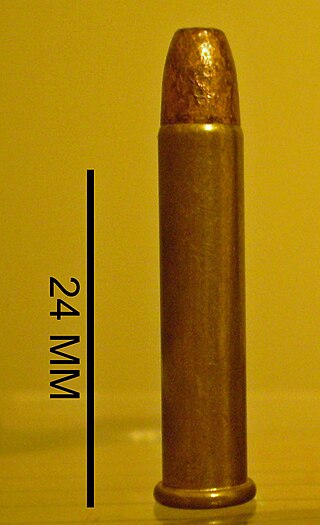
The .22 Winchester Magnum Rimfire, also known as the .22 WMR, .22 Magnum, .22 WMRF, .22 MRF, or .22 Mag, is a rimfire cartridge. Originally loaded with a bullet weight of 40 grains (2.6 g) delivering velocities in the 2,000 feet per second (610 m/s) range from a rifle barrel, .22 WMR is now loaded with bullet weights ranging from 50 grains (3.2 g) at 1,530 feet per second (470 m/s) to 30 grains (1.9 g) at 2,200 feet per second (670 m/s).
Marlin Firearms is an American manufacturer of semi-automatic, lever-action and bolt-action rifles. In the past the company made shotguns, derringers, and revolvers. Marlin owned the firearm manufacturer H&R Firearms. In 2007, Remington Arms, part of the Remington Outdoor Company, acquired Marlin Firearms. Remington produced Marlin-brand firearms at its Kentucky and New York manufacturing facilities. In 2020, Sturm, Ruger & Co. bought the Marlin business from bankrupt Remington Outdoor Company.
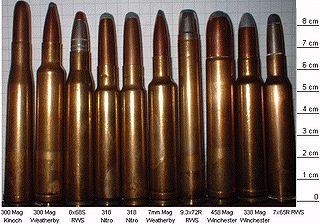
The .458 Winchester Magnum is a belted, straight-taper cased, Big Five game rifle cartridge. It was introduced commercially in 1956 by Winchester and first chambered in the Winchester Model 70 African rifle. It was designed to compete against the .450 Nitro Express and the .470 Nitro Express cartridges used in big bore British double rifles. The .458 Winchester Magnum remains one of the most popular large game cartridges, and most major ammunition manufacturers offer a selection of .458 ammunition.
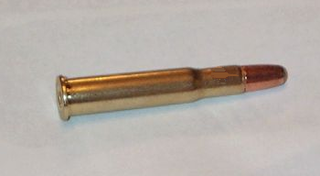
The .30-30 Winchester cartridge was first marketed for the Winchester Model 1894 lever-action rifle in 1895. The .30-30, as it is most commonly known, along with the .25-35 Winchester, was offered that year as the United States' first small-bore sporting rifle cartridges designed for smokeless powder. Since its introduction, it has been utilized alongside the development of flatter shooting cartridges, most prominently those derived from designs subsidized by interest in military expenditures. The .30-30 has remained in widespread use almost entirely because of reliable effectiveness in civilian applications, and has put food on the table for millions of people in hunting situations.
The Winchester Model 71 was a lever-action rifle introduced in 1935 and discontinued in 1958.

The .338 Winchester Magnum is a .338 in (8.6 mm) caliber, belted, rimless, bottlenecked cartridge introduced in 1958 by Winchester Repeating Arms. It is based on the blown-out, shortened .375 H&H Magnum. The .338 in (8.6 mm) is the caliber at which medium-bore cartridges are considered to begin. The .338 Winchester Magnum is the first choice among professional brown bear guides in Alaska to back up clients where a powerful stopping caliber is required on charging bears. It is also the most popular medium-bore cartridge in North America and has the most widely available choice in rifles among medium bore rifles. The action length is the same as a .30-06, and most major rifle manufacturers in the United States chamber rifles for the cartridge including the semi-automatic Browning BAR Mk II Safari, making it a very powerful combination against charging dangerous game. The cartridge was intended for larger North American big-game species and has found use as for the hunting of thin-skinned African plains-game species.
The Marlin Model 336 is a lever-action rifle and carbine made by Marlin Firearms. Since its introduction in 1948, it has been offered in a number of different calibers and barrel lengths, but is commonly chambered in .30-30 Winchester or .35 Remington, using a 20- or 24-inch barrel. Currently, several models with a 16-, 19- and 20-inch barrels are available in .30-30 Winchester. The Model 336 is now back in production as of March 27, 2023.
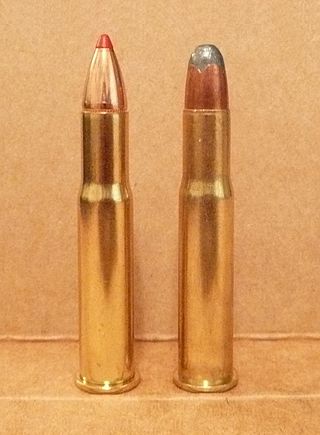
The .32 Winchester Special is a rimmed cartridge created in October 1901 for use in the Winchester Model 94 lever-action rifle. It is similar in name but unrelated to the .32-20 Winchester cartridge.
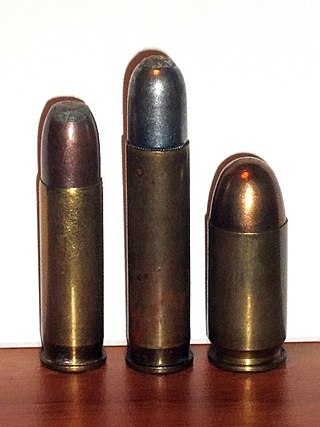
The .351 Winchester Self-Loading is an American rifle cartridge designed in 1906.
The .405 Winchester / 10.45x65mmR is a rimmed centerfire rifle cartridge introduced in 1904 for the Winchester 1895 lever-action rifle. It remains to this day one of the most powerful rimmed cartridge designed specifically for lever-action rifles; the only modern lever action cartridges that exceed its performance are the .50 Alaskan, .450 Alaskan, .475 Turnbull, .348 Turnbull, and the .450 Marlin. The .405 was highly regarded by U.S. President Theodore Roosevelt during his safari in East Africa.

The .348 Winchester is an American rifle cartridge. It was introduced in 1936, and developed for the Winchester Model 71 lever action rifle. The .348 was one of the most powerful rimmed rounds ever used in a lever action rifle.

The .38-55 Winchester cartridge, also known as the .38-55 WCF and the .38-55 Ballard, is a centerfire rifle cartridge. It was based on an earlier cartridge called the .38-50 Ballard Everlasting that was introduced in 1876 by the Ballard Rifle & Cartridge Company. The .38-55 Ballard was originally a Black-powder cartridge as used in Ballard and Marlin Firearms from 1876 onwards for various single-shot target rifles. Their 1893 lever-action rifle was also available in 38-55 using a Black-powder only barrel, or another barrel designated "Special Smokeless Steel" capable of safely using 38-55 cartridges loaded with the then relatively new and higher pressure smokeless powders. It was later offered by Winchester in its Model 1894, who usurped the name calling it the 38-55 Winchester, although it was an exact dimensional copy of the 38-55 Ballard. Winchester continued to use the round in various rifles until about 1940, and also used it in a few commemorative editions of rifles since then. In addition, Marlin offered it in some 336s, and it was used in non-lever action rifles such as the Remington-Lee bolt-action. The .38-55 Winchester is also the parent case for the .30-30 Winchester, .32 Winchester Special, and the .375 Winchester cartridges.

The .450 Marlin is a firearms cartridge designed as a modernized equivalent to the .45-70 cartridge. It was designed by a joint team of Marlin and Hornady engineers headed by Hornady's Mitch Mittelstaedt, and was released in 2000, with cartridges manufactured by Hornady and rifles manufactured by Marlin, mainly the Model 1895M levergun. The Browning BLR is also now available in .450 Marlin chambering, as is the Ruger No. 1. Marlin ceased manufacture of the 1895M rifle in 2009. In October 2022 it was rumored that Ruger Firearms, the new owner of Marlin Firearms, may be reintroducing the 450 Marlin in their Model 1895 guide gun, but this has not been confirmed by Marlin or Ruger.
The .50-110 WCF in modern 1886 Winchesters with modern steel barrels is the most powerful lever-action cartridge, with up to 6,000 foot-pounds (8,100 J) of energy.














